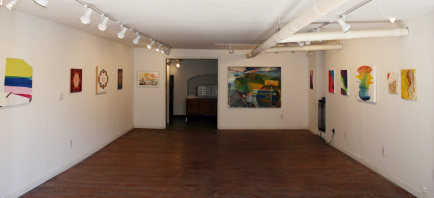Rhyme Not Reason - Curated by John Yau
Marilyn Lerner • Laura Newman • David Rhodes • Sherman Sam • Karla Wozniak

Rhyme, Not Reason
It is because I saw unexpected rhymes that brought the work of these five painters closer together that I chose to put their work in this exhibition.
That and the fact that: They are neither literalists nor ironists, as they recognize that these modes are both conventional and exhausted. They don’t believe reality is stable and therefore knowable. They don’t make paintings in which the viewer’s experience of their work is fixed and easily translatable into language. They don’t align themselves with a particular theory (or way of reading). Their works aren’t easily categorizable in terms of their predecessors.
In having all of the above in common, their work struck me as being fresh, as in not pickled, pre-served, canned, frozen, spoiled, rotten, or stale.
At times, their affinities are very subtle, and even attenuated, like a slant rhyme in a poem.
They cannot be designated as either abstract or representational artists, as each has concocted an individualized synthesis of both in their works.
They are preoccupied with how to infuse basic forms, such as circles and rectangles, with an optical power that isn’t purely about light.
They are materialists who recognize that what paint and light have in common is that they are things, at once visceral and elusive.
They don’t refer to the mass media, as if we all live in a virtual reality made up of images.
John Yau
It is because I saw unexpected rhymes that brought the work of these five painters closer together that I chose to put their work in this exhibition.
That and the fact that: They are neither literalists nor ironists, as they recognize that these modes are both conventional and exhausted. They don’t believe reality is stable and therefore knowable. They don’t make paintings in which the viewer’s experience of their work is fixed and easily translatable into language. They don’t align themselves with a particular theory (or way of reading). Their works aren’t easily categorizable in terms of their predecessors.
In having all of the above in common, their work struck me as being fresh, as in not pickled, pre-served, canned, frozen, spoiled, rotten, or stale.
At times, their affinities are very subtle, and even attenuated, like a slant rhyme in a poem.
They cannot be designated as either abstract or representational artists, as each has concocted an individualized synthesis of both in their works.
They are preoccupied with how to infuse basic forms, such as circles and rectangles, with an optical power that isn’t purely about light.
They are materialists who recognize that what paint and light have in common is that they are things, at once visceral and elusive.
They don’t refer to the mass media, as if we all live in a virtual reality made up of images.
John Yau
